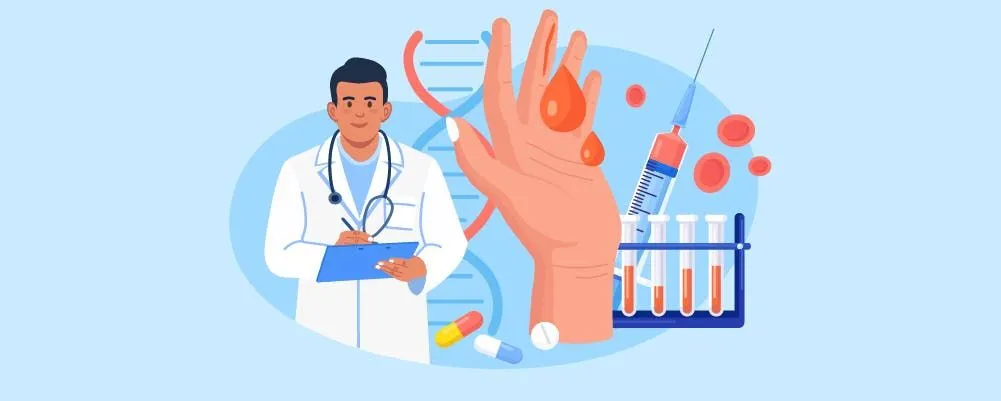Your session is about to expire
A Guide To 7 Of The Most Common Genetic Disorder
Introduction

There are many medical conditions out there. Some of them are developed as we get older and can impact a person’s physical health or sometimes the way that they think. Others are ones that we’re born with.
Genetic disorders are still something that we don’t have as much information about, but there are some common genetic disorders that we know more about than others. Here’s what you need to know about the most common genetic disorders out there.
What Are Genetic Disorders?
According to the National Human Genome Research Institute, a genetic disorder is a "disease caused in whole or in part by a change in the DNA sequence away from the normal sequence."
So what does this mean? Well, you have a bunch of genes in your body. Typically many of them will behave and look the same way, but if you have a genetic disorder then one of your genes may mutate and be different from that of someone without a genetic disorder. The mutation can happen to one gene or several.
Genetic disorders are often things that can happen by completely random chance, but there are some things that may make someone more prone to getting a genetic disorder when their mother is pregnant. For instance, some genetic disorders may be more likely to occur if there is a family history of a certain genetic disorder. Some may be hereditary.
Some genetic disorders, such as Down’s Syndrome, Edward’s Syndrome and Patau’s Syndrome, can be detected early during pregnancy due to blood tests, a procedure known as amniocentesis and ultrasounds conducted on the mother. Others are often diagnosed at birth or sometimes even many years later.
There are actually a few different types of genetic disorders, primarily three of them - single gene, complex disorders and chromosomal.
The Most Common Genetic Disorders

There are a number of genetic disorders that can commonly occur in people. Here are just a few of them and everything that you need to know about them.
Down Syndrome
Perhaps the most common genetic disorder of all and the one that people tend to know the most about is Down Syndrome. But how much do you actually know about it?
Cause Of The Condition
Down Syndrome, also known as Trisomy 21, is what’s known as a chromosomal condition. Chromosomal conditions happen when there are either more or less chromosomes in the body than you would usually expect to find. In the ‘average’ person, there would usually be just 46 chromosomes in the body. If there is an extra chromosome in the body, then this is something known as a Trisomy. There are a lot of different trisomies - not just Trisomy 21. For instance, there is also Trisomy 13, or Patau’s Syndrome.
In the case of Trisomy 21 or Down Syndrome, there is an additional 21st Chromosome. Down Syndrome is the most commonly diagnosed chromosomal condition in the United States, and roughly 1 in 700 babies have Down Syndrome.
While people often wish to know what causes Down Syndrome, the fact is that we don’t fully know what causes this condition. Researchers are still yet to find out why this extra chromosome occurs in some babies but not others. It is believed that older women are more at risk of having a baby with Down Syndrome. The risk of having a baby with Down Syndrome does increase slightly with advancing maternal age, particularly in those who are 35 or older. With that being said though, it’s interesting to note that Down Syndrome is actually more common in mothers younger than 35 years of age since more babies are born to women in this age group.
Common Symptoms
It’s important to note that not all people with Down Syndrome are the same - each person that has Down Syndrome is unique with their own personalities, challenges and strengths - just like someone without Down Syndrome.
With that being said there are a couple of commonly recognized physical development symptoms that tend to be prevalent among people who have Down Syndrome.
There can sometimes also be language delays and difficulties with memory. They may also be more likely to experience other complications, like heart defects, sleep apnea, defects of the gastrointestinal system and more.
Existing Treatments
At present, there is no cure for Down Syndrome - it’s a condition that will remain with a person for the rest of their life. With that being said, there are a number of services designed to help people with Down Syndrome thrive. From a young age, many children will be offered occupational, speech and physical therapy. There are also treatments available to help with some of the physical and intellectual symptoms of Down Syndrome.
How Can Family Members and Caregivers Cope?
If your child or family member has Down Syndrome, it’s worthwhile to speak to other families of individuals with Down Syndrome. Having the support of others in the same situation as you can go a long way in helping you to feel more confident and less alone. Reach out to other family members too - having a support system is incredibly important.
Make sure that you ask for help too, whether that’s from medical professionals, family or anyone else that would be able to help you.
One of the best things that you can do for your child and yourself is to keep a routine, however. This will help you to feel more in control, and will help your child to thrive.
Up and Coming Research/Hope For The Future

New research is being conducted throughout the globe for individuals with Down Syndrome every single day. Research is focused on a number of different areas, from quality of life improvements to further understanding the causes of Down Syndrome.
You can see just how much we are learning about Down Syndrome as time goes on from things like the Down Syndrome Research Forum. Some research on Brain Development for the 2022 forum, for instance, could lead us to further understanding the brains of those with Down Syndrome so better treatments can be developed for helping them to live as normal a life as possible, without being at all hindered by their disability.
Thalassemia
You may never have heard of Thalassemia before, but it’s a condition that is often screened for during a mother’s pregnancy. This particular condition is a blood disorder that can be passed on from the parents to the child. It essentially causes you to have more hemoglobin in your body than what’s typical for your average person. The problem with this is that it can often cause anemia.
Cause Of The Condition
Thalassemia is a condition that occurs when the DNA of the cells that create hemoglobin mutate. It’s a mutation that is often passed on from a parent to a child.
It’s important to note that a parent can be a carrier with Thalassemia and not know it because they have no symptoms. That’s why it’s often screened for during pregnancy. Thalassemia symptoms can range from mild to severe. Many people with severe thalassemia don’t survive birth or will need to have blood transfusions for most of their lives.
Thalassemia is more common in certain ancestries, including in African Americans and people from Southeast Asian and Mediterranean descent.
Common Symptoms
Thalassemia can come in many different forms, and thus the symptoms can vary massively. There are some common symptoms though, including:
- Fatigue or severe tiredness
- Swelling in the abdomen
- Darker urine
- Skin with a yellow or pale appearance
- Slower growth
- Feeling weak
The symptoms can often show right after birth, but some people won’t notice any symptoms until later on.
Existing Treatments
The treatments that you get will depend on the type of illness that you have. If you don’t have a particularly severe form then you may not need any treatment, but in some cases blood transfusions, stem cell transplants or chelation therapy may be used to treat the condition.
How Can Family Members and Caregivers Cope?
Thalassemia can be a hard thing to watch your child experience. The main thing is to remember that it’s okay to ask for help if you need it, from your healthcare team or from other family members.
Up and Coming Research/Hope For The Future
The future looks bright for research when it comes to Thalassemia. We’re learning more about gene therapies, and some of these gene therapies may even yield a cure for the condition. We aren’t there quite yet, but the developments in research certainly appear to be promising.
Cystic Fibrosis
Cystic fibrosis is a chronic condition that is often inherited from the parents. If both of the parents have it, then there’s roughly a 25 percent chance of developing it. It often causes mucus to build up in the body, particularly in the reproductive system, respiratory tracts and the digestive system.
Cause Of The Condition
Cystic fibrosis is caused by a mutation of the genes, and it influences the way that salt and water moves in and out of the cells in the body. As with other genetic conditions, it’s something that a person is born with and it’s often inherited from the parents. Naturally, if both of the parents are carriers then there’s a higher chance of getting it. If one of the parents has the condition then there’s roughly a 1 in 2 chance of the child having it too.
It’s important to note that a parent can be a carrier with Thalassemia and not know it because they have no symptoms. That’s why it’s often screened for during pregnancy. Thalassemia symptoms can range from mild to severe. Many people with severe thalassemia don’t survive birth or will need to have blood transfusions for most of their lives.
Common Symptoms
Some common symptoms of cystic fibrosis include the following:
- Repeated chest infections
- Diarrhoea, constipation or smelly stools
- Struggles to gain weight and grow
- Coughing and other issues like shortness of breath related to the respiratory system
- Bowel obstruction in babies
Existing Treatments
Again, cystic fibrosis is another genetic condition that does not currently have a cure, but there are a wide variety of different treatments for the symptoms associated with it. Patients with the condition are often monitored regularly and will have a care plan tailored to their requirements.
Many patients will often be given medicines to help them to deal with the lung problems they may experience. Other recommended treatments include exercise, airway clearance techniques and lung transplants.
How Can Family Members and Caregivers Cope?
It’s often hard for family members to watch their loved one suffer with the symptoms of cystic fibrosis. In many cases, parents make their child and their condition their entire focus. It’s important that through that, caregivers do not ignore their own needs. If you are noticing issues with your mental health, it’s imperative that you seek help.
Other things that can help include making yourself informed about cystic fibrosis, and doing things to keep your wellbeing in check like eating healthily, exercising and sleeping in a regular schedule if you can.
Up and Coming Research/Hope For The Future
We’re learning more about new ways to treat cystic fibrosis as time goes on, and more scientific breakthroughs are happening by the day. For instance, some scientists believe based on initial studies that an antifungal drug may be efficient for treating cystic fibrosis. Most current research is focusing on symptoms management and developing new treatments that can help sufferers to have a prolonged life expectancy and a more enjoyable life.
Tay-Sachs disease
It is estimated that around 1 in 250 people in the world have Tay Sachs disease, and it’s a chromosomal defect. Particularly, the issue is with chromosome 15. It can often be fatal in children, though it’s possible for people to be diagnosed with a late onset version of the condition as adults.
Cause Of The Condition
This condition is passed on from parent to child, and happens as a result of a problem with the HEXA genes that come from the parents. People from certain communities are more at risk of carrying the gene change, such as those from Central European and Eastern Jewish Communities, the Cajun community of Louisiana, and more.
It’s important to note that a parent can be a carrier with Thalassemia and not know it because they have no symptoms. That’s why it’s often screened for during pregnancy. Thalassemia symptoms can range from mild to severe. Many people with severe thalassemia don’t survive birth or will need to have blood transfusions for most of their lives.
Common Symptoms
Many people with this condition don’t survive beyond childhood, so many of these symptoms are ones that will be found in infants typically between the ages of 3 to 6 months. The symptoms include the following:
- Hearing loss
- Vision loss
- Struggles with movement
- Muscle weakness
- Motor skills lost
- Red spots in eyes
- Severe startle response to loud noises
- Swallowing problems
- Excessive head growth
- Mental function loss
Existing Treatments
There’s currently no cure for this condition, but many treatments help to ease the symptoms of the disease. There’s no way to slow the progression at present either, so every treatment is to make it easier to live with the condition. Some treatments involve providing medications, for instance for the seizures that may occur as a result of the condition.
Respiratory care may also be provided, alongside nutritional help such as a feeding tube being fitted into the nose. Physical therapy may also be provided alongside occupational therapy and speech and language therapy.
How Can Family Members and Caregivers Cope?
Learning that your child has Tay-Sach’s disease can be devastating, so it’s vital that you do things to look out for your own wellbeing too. Don’t hesitate to speak to your child’s care providers to get more information and resources - they may also be able to point you in the direction of some support groups that you can go to.
Up and Coming Research/Hope For The Future
Unfortunately as it currently stands there isn’t a cure for Tay-Sachs disease, but research is regularly being conducted so that we can learn more about this devastating condition. Some research that’s currently underway is focused on stem cell transplantation, gene therapy and enzyme replacement therapy. It is thought that these treatments may eventually be able to slow the progression of the condition.
Sickle Cell Anemia
Sickle cell anemia is a condition that impacts the red blood cells in the body. There are a number of different sickle cell diseases, but sickle cell anemia is by far the most severe kind that a person can have. This disease is characterized by red blood cells that are shaped unusually, and as a result the cells in question don’t live very long. They can block the blood vessels in the body.
Cause Of The Condition
Sickle cell diseases are typically caused by genes that often come from the parents. These genes will influence the ways in which the blood cells develop. If parents are carriers of the gene then there’s a roughly 1 in 4 chance that the child will have it. Many parents won’t even know that they are carriers of sickle cell disease.
Some people are at higher risk of being carriers of sickle cell disease. For instance, if you come from an African or a Caribbean background then you may be more likely to develop sickle cell anemia.
Common Symptoms

People who present with symptoms of sickle cell anemia often do so from a very young age. It’s often noticed in early childhood, though it’s entirely possible for a child to have it and barely notice the symptoms most of the time. The severity can vary.
There are a few key symptoms of sickle cell anemia. First is something called sickle cell crises, which are incredibly painful episodes that will affect certain areas of the body. These crises can sometimes last for a week.
People with this condition may also be prone to getting infections and of course anemia. Some less common symptoms include delayed childhood growth, pain in the joints and bones, strokes, open sores on the lower half of the legs and high blood pressure.
Existing Treatments
Most people with sickle cell anemia are going to need treatment for their entire lives. Individuals with the condition are given special care plans based on their particular symptoms, and are advised on what to do to avoid sickle cell crises.
People are also given medication to manage pain episodes when they have sickle cell anemia, and are advised to take folic acid. Occasionally blood transfusions may be required when the condition is particularly severe.
Technically, you can cure sickle cell anemia with stem cell or bone marrow transplants. With that being said, this isn’t a treatment method that’s often done because there are some massive risks involved in the procedure. It’s often a treatment that’s considered as a last resort and only for very severe cases.
How Can Family Members and Caregivers Cope?
It can be a challenge to be a caregiver of someone with sickle cell disease. It can often take a huge toll on your emotional and physical health.
Getting as much information as possible will be a huge asset here. Nobody likes to see a loved one in pain, but if you know how to help a loved one having a bad pain episode with their sickle cell disease then you can feel more empowered.
For your own mental health, there are some things that you can do to cope with it. Make sure that you are getting out and speaking to people regularly - support groups can often be helpful. Make time for your own hobbies and the things that you care about, and try to stay away from triggers of pain crises if possible.
Up and Coming Research/Hope For The Future
Researchers are making massive strides on research for sickle cell anemia. In fact, in the UK a life changing treatment will be rolled out to people through the National Health Service. It is believed that this treatment, a drug known as crizanlizumab, could be crucial in improving the quality of life of people that suffer with the illness.
It’s also possible that gene therapy could cure the disease. We still have much to learn about this disease, but there is certainly a light at the end of the tunnel thanks to all of the recent research.
Turner syndrome
Turner syndrome is a condition that impacts the sex chromosomes, particularly the X chromosomes. This condition is one that is only inherited by females.
Cause Of The Condition
So what causes Turner syndrome? Technically speaking, the condition occurs when part of or all of one of the X chromosomes in a female’s body is missing. Much like with Down Syndrome, Turner Syndrome is a condition that can often occur randomly during conception. It often occurs because there is an issue with the sperm or egg, or sometimes it can happen as the fetus is developing in the womb. It’s not a condition that’s influenced by family history.
Common Symptoms
Turner syndrome can sometimes be detected before birth during prenatal screening. It can sometimes be detected via blood test or there may be some issues on the ultrasound. Most of the time it’s detected afterwards though, with young baby girls having short fingers and toes, a low hairline on the back of the head, small height at birth swelling in the hands and feet, arms that may turn outwards, and a broad chest with nipples spaced widely apart.
Later in life, people may show slowed growth and many women have ovarian insufficiency and short stature. Women with Turner Syndrome often tend to have issues related to reproduction and the menstrual cycle.
Existing Treatments
The treatment that someone may get for Turner Syndrome depends on the main symptoms that they get. For instance, if the person in question is experiencing shorter stature in adolescence and childhood, they may be given growth hormone therapy to help them to increase their height.
Many girls will also be given estrogen therapy to encourage them to start puberty. It will help them to develop breasts, volume of the uterus and bone mineralization.
Many women will also require fertility treatment if they wish to become pregnant later in life. While it is possible for some women to achieve a pregnancy without having fertility treatment, it is incredibly uncommon.
How Can Family Members and Caregivers Cope?
If you have a loved one with Turner Syndrome, the best thing to do is to become informed. Learn what you can about the condition and how to support your loved one, both physically and emotionally. Support groups are again a big asset, and these are also available for girls experiencing the condition. Be sure to ask for support from your child’s medical team too.
Up and Coming Research/Hope For The Future
There’s still a lot that we don’t know about Turner Syndrome. New research is being undertaken all the time though, and as a result we are learning more about treatments for the associated conditions. Thanks to organisations like the Turner Syndrome Foundation , massive discoveries are being made all the time. With time, we can hopefully find out even more about Turner Syndrome, such as more information about what causes it.
Fragile X syndrome
This genetic condition can affect both sexes but it is much more likely to come up in males. It’s a condition that often is associated with the intellectual difficulties that it can cause.
Cause Of The Condition
This condition is present thanks to an alteration to the FMR1 gene in the X-Chromosome. The gene in question is responsible for creating certain proteins that allow the brain to function as it should. Since the gene is altered, it doesn’t behave in the way that it’s supposed to - thus, a person has Fragile X syndrome.
The risk of a person having Fragile X syndrome is much higher if the parents are carriers of the gene. There are roughly 1 in 150 women and 1 in 800 men who are carriers of this gene. They may not even know that they are carriers if they don’t undergo testing before conception or during pregnancy.
Common Symptoms
Children that have Fragile X syndrome are more likely to experience delays in their development - for instance, they may not walk, sit or talk on the same timeline as others that are the same age.
They may also experience difficulties with learning and sometimes learning disabilities. Many also struggle with behavioral and social issues.
As previously mentioned, males are more likely to be badly affected by the condition because they only have one X chromosome.
Existing Treatments

At present there isn’t a cure for Fragile X syndrome. There are treatments available that can help with improving quality of life for people with Fragile X syndrome, alongside helping them to learn essential skills. Some people may need therapy for learning things like walking, talking and more. Most of the time, pediatricians and specialists will work on a plan to focus on the key areas of difficulty that the child may experience.
How Can Family Members and Caregivers Cope?
Having a child with Fragile X syndrome can often be challenging, so finding support is crucial. Support groups can help you to learn more about the condition, while also connecting with people that have been through similar experiences. Be sure to take time for your own self care too, and ask for help when needed.
Up and Coming Research/Hope For The Future
A lot of research is taking place to learn more about Fragile X syndrome. In particular, the CDC is working on learning more about the conditions that can sometimes occuralongside the condition, the outcomes, impacts on families and new interventions. With time, we are seeing more clinical trials taking place to learn more about the condition, and more information is coming to light about how to treat it.
Summary

Citations
https://geneticalliance.org.uk/information/learn-about-genetics/genetic-disorders/
https://www.webmd.com/children/trisomy-13
https://www.cdc.gov/ncbddd/birthdefects/downsyndrome/data.html
https://www.down-syndrome.org/en-gb/research/forum/2022/program
https://www.frontiersin.org/articles/10.3389/fphar.2021.730873/full
https://www.cff.org/research-clinical-trials
https://www.news-medical.net/health/Tay-Sachs-Disease-Research.aspx
https://www.england.nhs.uk/2021/10/nhs-announces-deal-for-life-changing-sickle-cell-treatment/
https://www.webmd.com/a-to-z-guides/news/20211213/could-gene-therapy-help-cure-sickle-cell-disease
https://www.nature.com/articles/nrendo.2017.87
https://labblog.uofmhealth.org/lab-report/fragile-x-syndrome-research-gains-momentum